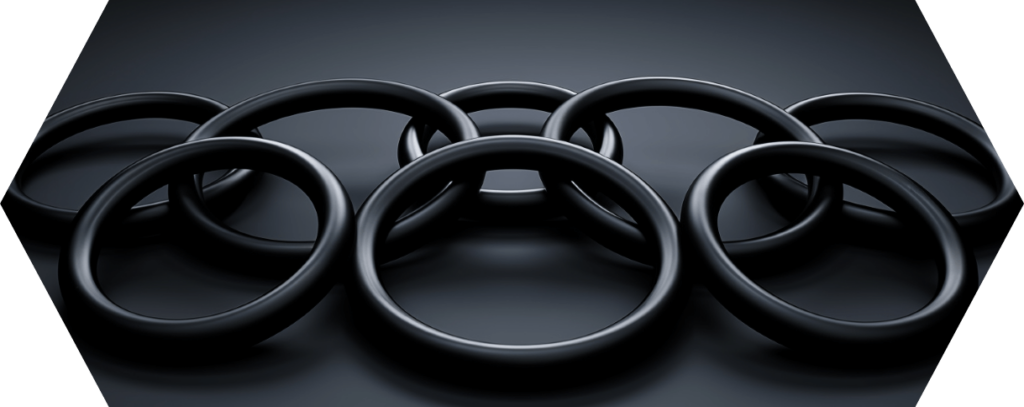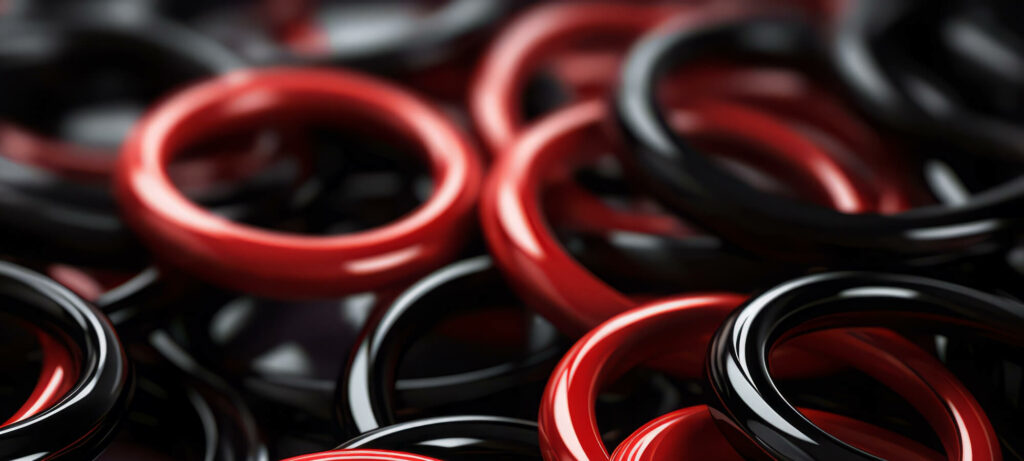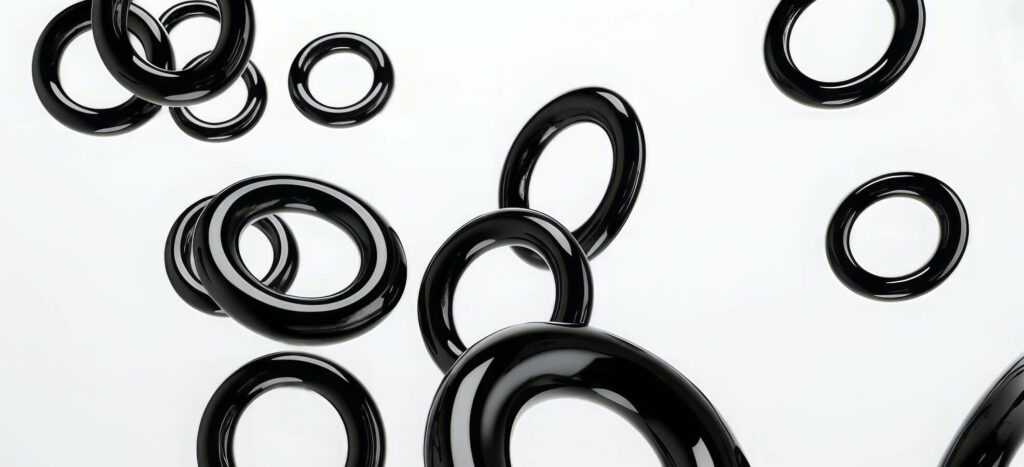FKM O-RINGS
FKM O-rings: Everything you need to know
The fluororubber (FKM) is the all-rounder among O-ring materials.
This is because it combines excellent media resistance with high temperature resistance from -25°C to +200°C. As a result, FKM O-rings are used in many different industries, such as the chemical and automotive sectors.
It is important to know that FKM O-rings are also known under the designations (FPM and VITON).

Feature | Value |
|---|---|
ISO designation | FKM |
Trade names | FPM, VITON |
Chemical name | Fluororubber |
Media resistance | Excellent media resistance |
Temperature resistance | -25°C to +200°C |
Standard color | Black |
Standard hardness | 75 Shore A |
Scope | Chemistry, oil & gas, vacuum |
Production | Compression molding and injection molding |
Tolerances | DIN ISO 3601 |
Durability | 10 years |
Differences in commodity prices
Material | NBR | EPDM | VMQ | HNBR | FKM | PTFE | FEP | FFKM |
|---|---|---|---|---|---|---|---|---|
Factor | 1 | 1,5 | 1,9 | 2,7 | 3,9 | 24 | 51 | 329 |
Correct interpretation: NBR is the cheapest material compared to the other O-ring materials. The factor indicates how much more expensive a material is compared to NBR.
Example: FKM is 3.9 times more expensive than NBR. FFKM is 329x more expensive than NBR.
REQUEST FKM O-RINGS QUICKLY AND EASILY?
Almost any dimension available
Over 10,000 FKM dimensions available from stock
Offer received in record time
No minimum order values or minimum quantities
#1 FKM O-rings: The 5 most important advantages
1. excellent media resistance
2. high temperature resistance
3. long shelf life
4. low gas permeability
5. high stock availability
Fluororubber (FKM) is one of the fluoroelastomers that are playing an increasingly important role in demanding sealing technology applications.
Invented in the 1950s, FKM O-rings are now an integral part of the sealing world. FKM O-rings are a particularly suitable choice for high temperatures in combination with aggressive media.
Due to these material properties FKM O-rings were initially mainly used in the aerospace industry. They are now represented in almost all industries.
A comparison of the most important O-ring materials
Material | Temperature resistance | Chemical resistance | Elasticity |
|---|---|---|---|
NBR | -30°C to +120°C | Low | High |
HNBR | -30°C to +150°C | Medium | High |
EPDM | -45°C to +150°C | Medium | High |
SILICONE | -60°C to +200°C | Low | High |
FKM (VITON) | -25°C to +200°C | Medium | High |
FEP coated | -60°C to +200°C | High | Medium |
PTFE | -250°C to +250°C | High | Low |
FFKM | -40°C to +340°C | High | High |
#2 FKM O-rings: The 3 most common areas of application
Automotive industry
The automotive industry is another key area of application for FKM O-rings.
In combustion engines, FKM is used in contact with engine oil or cooling water. In the fuel system, FKM seals come into contact with gasoline and diesel as well as special fuels.
The manufacturers use FKM seals from the tank through the lines to the injection system.
Oil and gas industry
Among other things, FKM materials are approved for use as seals in gas supply and gas consumption facilities.
DIN EN 549 specifies the requirements for this area of application. In addition to FKM, the main polymers used are NBR and VMQ are used.
Operation is characterized by high pressure and a wide temperature range. The tightness and resistance in contact with the medium also make O-rings made of FKM a suitable option for oxygen fittings.
Food industry
In the biomedical and food sectors, biocompatibility is an indispensable property of sealing materials.
In addition to EPDM and PU, FKM is suitable for applications of this type. Challenging conditions prevail not only in productive operation, but also during sterilization. High temperatures and aggressive media put a strain on the sealing materials.
This also applies to use in chemical and process engineering. This is because standard fluoroelastomers exhibit weaknesses against
superheated steam
and common CIP media.
#3 FKM O-rings: Evaluation of media resistance
The comprehensive resistance profile makes FKM suitable for use in many mechanical components and machines.
FKM is resistant to
- Mineral oils and greases
- Vegetable and animal oils and fats
- Aliphatic and aromatic hydrocarbons
- Fuels (diesel, gasoline, fuels containing methanol)
- Chlorinated hydrocarbons
- Silicone oils and lubricants
FKM is not resistant to
- Ammonia gas
- Amines
- Alkalis
- High-heat steam (>120°C)
The good resistance to ageing speaks for the use of sealing elements made of FKM. They retain their gap-bridging properties for a long time and reliably seal the areas against each other.
That FKM materials with lubricants based on mineral oil-based and silicone-based is an advantage over other rubbers. For example, EPDM is not compatible with petrochemical lubricants. Silicone rubbers, on the other hand, do not harmonize with silicone oil.

#4 FKM O-rings: Temperature resistance
FKM Standard = -25°C to +200°C
FKM Extreme = -40°C to +225°C
However, it should be noted that the temperature limits of FKM materials depend on the respective contact medium depend on the contact medium.
FKM can be exposed to continuous temperatures of up to 200°C in contact with fossil-based lubricants. This also applies to contact with air. Only special material qualities can withstand a continuous temperature of 130°C in water.
Sealing elements made of FFKM reach higher continuous temperatures, especially in water and air. If particularly high resistance to superheated water vapor is required, FFKM should be preferred. This is the case with aggressive CIP processes in the hygiene industry, for example.
#5 FKM O-rings: Mechanical properties
1. excellent abrasion behavior
2. suitable for dynamic applications
3. suitable for high vacuum applications
Another important material property in sealing technology is mechanical wear. FKM shows good abrasion behavior.
This group also includes NBR and EPDM, which are suitable for light dynamic applications.
FKM is generally well suited for high vacuum applications. In terms of gas permeability, FKM achieves similarly good values to butyl rubber (IIR). However, this material often reaches its application limit at 140°C in air.
High-vacuum applications include electron microscopes, coatings using gas phase deposition and mass spectrometers. mass spectrometers.

#6 FKM O-rings: Optimum groove design
- Compression in the groove should be approx. 20%
- 20% of the groove should still be free after grouting
- Always design grooves according to the standard tables available on the market
- Permanent elongation after installation should be less than 6%
- Permanent compression after installation should be less than 6%
1. no sharp edges
2. Use a suitable O-ring tool
3. Clean the groove space thoroughly before assembly
4. Use suitable assembly grease (observe media resistance)
5. Observe the 20% insertion chamfer
6. Do not expand elastic O-rings by more than 50% during installation
#7 VITON O-rings: Difference to FKM O-rings
Viton® O-rings, a special type of FKM O-rings from the company DuPontare synthetic high-performance fluoropolymer elastomers (rubbers) and are often used in O-rings for demanding applications.
They are classified as FKM according to ASTM D1418 and ISO 1629 and are preferred due to their high resistance to extreme heat, aggressive weather conditions, oxygen, minerals and other influences.
Viton® has become a generic term for most FKM materials in the industry.
Viton® (FKM) O-rings are suitable for acids, aliphatic hydrocarbons, oxidizing agents and all petroleum products. They are particularly suitable for vacuum applications and have low gas permeability. Viton has a temperature application range of -25 to 200°C.

#8 FKM O-rings: Further information
Finally, we would like to answer a few questions that we are frequently asked in everyday life.
#8.1 Is Viton the same as FKM?
Yes, Viton and FKM are both designations for fluororubber. However, Viton is the product of the DuPont company and stands for a very specific type of fluororubber. Accordingly, FKM is the current ISO designation for fluororubber and Viton is a brand of fluororubber.
FKM = Current ISO designation for the material fluororubber
FPM = Obsolete ISO designation for the material fluororubber
VITON = Trade name of the company DuPont for the material fluororubber
#8.2 Where can I find the FKM data sheet?
You can easily view the data sheet for our FKM O-rings directly on our website and download it if you wish.
#8.3 What is FKM material?
FKM (formerly FPM) stands for fluororubber and was invented in the 1950s. It is characterized by its high thermal resistance and excellent media resistance.
The combination of these two characteristics makes FKM a real all-rounder and is now used in various industries.
#8.4 What is the FKM O-ring temperature range?
Standard fluororubber (FKM) has a high temperature resistance from -25°C to +200°C. There are also other FKM variants that can withstand higher or lower temperatures.
These higher-quality FKM compounds are marketed under the name “ FKM Extreme “. They have excellent media resistance and can permanently withstand temperatures from -40°C to +225°C.
“I am convinced that we should share our knowledge with the world. I hope I have been able to answer all your questions. If you have any further questions, please feel free to contact us at any time. We will be happy to help you.”

Lord of the O-rings
Author of the Sealing Academy
